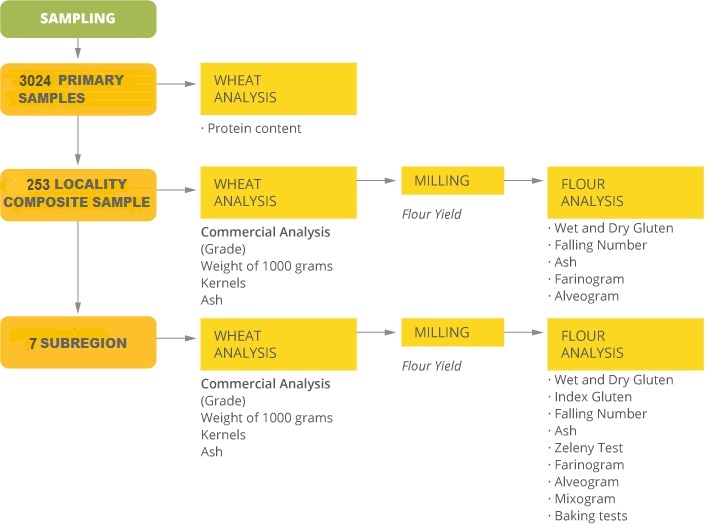 PROCEDURE
PROCEDURE
The primary samples were sent to the respective Arbitration Chambers Laboratories according to the wheat sub region of origin. The Santa Fe Arbitration Chamber received samples from the Sub region I and the Northeast of the country, the Rosario Chamber those from the Sub region II N and from the Northeast of the country, the Buenos Aires Chamber those from the Sub regions II S, IV and from the Northwest of the country, Entre Ríos Chamber those from the Sub region III, the Bahía Blanca Chamber those from the Sub regions IV and V S, and the Córdoba Chamber those from the Sub region V N.
These Arbitration Chambers made Locality Composite Samples of 4 kg of wheat, representative of 4,000 tons each one. These ones performed the commercial analysis (grade), weight of 1,000 kernels, and ash.
The composite samples were sent reserving a part in order to prepare the Subregion Composite Samples. It was decided to use only one mill for all the composite samples by locality, so as to minimize differences in the flour features due to the grinding.
With the flour resulting from the grinding, the Arbitration Chambers, in this case Buenos Aires, Bahía Blanca and Rosario, carried out the analyses of Falling Number, Gluten, Alveogram, Farinogram and Ash.
Prior to performing the analysis a ring test was carried out among the participating laboratories so that the results could be comparative.
On the other hand, with the locality composite samples portions kept apart, and in proportion to their representativeness, The Arbitration Chambers made the Composite Sample of each Subregion, 9 in total, weighing 4 kg each one, and performing Test Weight, Proteins, Ash and Weight of 1,000 kernels in wheat. These samples were used by the SENASA to perform the grinding in Bühler mill and then, The Marcos Juarez Experimental Station of INTA carried out the following analyses in flour: Falling Number, Gluten, Ash, Zeleny Test, Alveogram, Farinogram, Mixogram and Baking Test.
The present report was coordinated by the Agrifood Quality Direction of the SENASA.
| PROCEDURE TO OBTAIN ANALYTICAL RESULTS |

|
In order to evaluate the industrial quality of wheat, characteristics of grain, its behavior in milling, different analytical values, alveographic and farinographic curves, and bread quality, are taken into consideration.
Agricultural and weather conditions can easily affect quality, and even the most remarkable varieties can present a questionable quality. Consequently any qualitative abnormality must be observed in different environments or periods of cultivation in order to assure that the result is due tothe variety.
Grain characteristics are prominent quality factors in wheat appraisal. To a low test weight corresponds an unsatisfactory milling, low flour yield and inferior quality. Behavior in the milling is another important aspect in the quality criterion. Wheat of low extraction of flour or high ash content constitutes a real problem. While some areas are favorable for the highest amount of minerals, there are certain varieties which have lower ash content in the grain and, therefore, in the flour.
The quantity and quality of flour proteins are essential to determine the bread quality. Rheologic analysis include indirect determinations of quality such as alveographic, mixographic and farinographic curves which provide the necessary information to evaluate bread force, time for dough development, water absorption and stability or behavior during kneading.
Bread quality of wheat is determined by flour absorption of water, time of kneading, dough aspect, volume of bread, porosity and whiteness of the crumb. All those characteristics constitute the bread value of wheat, being some of them considered in a subjective way and others through equipement.
The volume of bread is one of the most important factors of flour potential force, since it demonstrates the gluten capacity of expansion through gas produced by the contact between yeast and sugars, and at the same time, the ability to hold the gas during the whole expansion.
Wheat with a low loaf volume, or with a high one, but with huge alveolus or holes inside, is not desired, as they are the evidence of weak flours. It is essential to know the flour protein content during baking, since at a low level there will be less expansion and final volume, which is not due to the quality but to the quantity of proteins.







